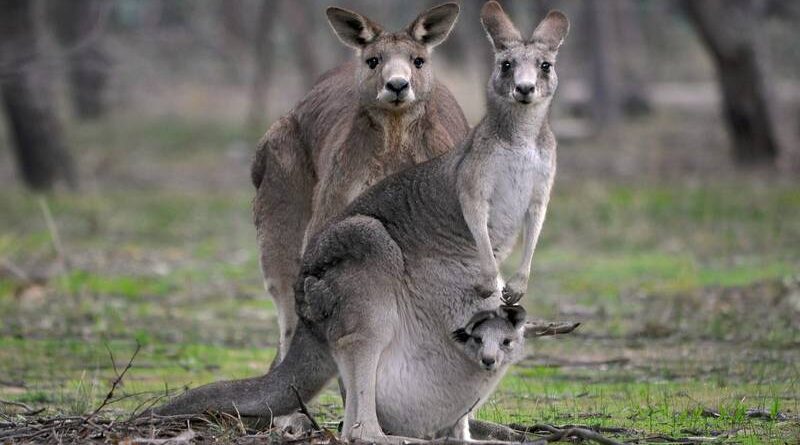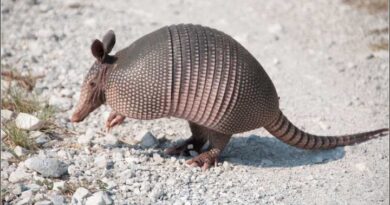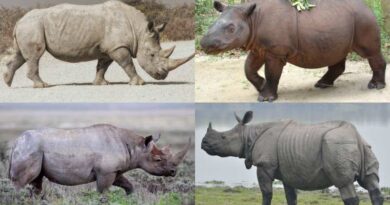KANGAROO
In 1770, Captain Cook was sailing near the continent of Australia when he ran into a coral reef and wrecked his ship. While it was being fixed, he and his friends went to the nearby mainland to look around. They were amazed to see an animal jumping around on its hind legs, so they asked the people who lived there what it was. Since the natives did not speak English, they said “Kangaroo,” which means “I don’t understand you.” Captain Cook thought they were telling him the name of the animal, so people have called it a “kangaroo” ever since.
The explorers were surprised to see that these animals didn’t stand on four equal legs like most animals. Instead, they sat up on their big back feet and carried their small front feet high up against their chests, like little hands. They saw that each female had a pouch of skin, like a big pocket of soft fur had been added to her coat. The pouch was on the front of her body, and it was where she carried her baby. Some of the babies’ faces could be seen poking out of the tops of their pouches. The way these animals moved also interested them. They paid close attention and saw that when the kangaroos were eating, they moved slowly by pushing themselves up with their strong tails and short front legs. When they were in this position, they swung their huge back legs forward, and then did it again. By using the tail in this way, it was as if they had five legs instead of the usual four. With every step, they moved about one metre forward.
When they are scared, kangaroos change in a big way. Now, neither the front legs nor the tail touched the ground. Instead, the huge hind feet stamped on the ground, sending the animal forward in a huge leap. The body was perfectly balanced, so the kangaroos could keep jumping without stopping to rest. The front of the body leaned forward, and it was as heavy as the heavy tail that stuck straight out behind it.
The first explorers who came to Australia had never seen anything like it, and they were amazed by how fast the kangaroos were. They chose to try it out. They had some hunting dogs on their ship, which they had brought with them on their long journey. Greyhounds, these dogs, were so fast that the explorers were sure nothing could get away from them. They were wrong, though. When the greyhounds were set free to catch the kangaroos, they were not able to do so. This wasn’t because the dogs were slower, but because the kangaroos just jumped over the tall grass and out of sight when they got to it. How to get there and lose their prey. But the strange way the kangaroo moved was not the biggest surprise. Later, when the animals could be studied more closely, it was found that the baby kangaroo was even stranger than its parents.
It only takes a month for the body kangaroo to grow inside its mother. The female then spends two hours cleaning and licking the inside of her pouch right before the baby is born. She sits up in an odd way, sometimes leaning against a tree and bringing her tail forward between her back legs. As soon as the baby is born, it starts to crawl up the front of its mother’s body, twisting from side to side like a snake as it climbs higher and higher. Finally, with one last big effort, it climbs into her wet pouch and safety. The whole amazing trip takes only about three minutes, and the mother doesn’t help. The most interesting thing about this tiny baby is how much lighter it is than its huge mother. It’s hard to believe, but she can weigh 80,000 times as much as her newborn baby. The tiny creature is only 2 centimetres long and weighs only 0.75 of a gramme. It can’t see or hear, but it has a big nose that helps it find its way. It has no fur on its skin, and its front legs are bigger than its hind legs, which is the opposite of what an adult kangaroo does. It pulls itself up through its mother’s fur by using its strong front feet.
Once the baby is inside the pouch, it looks for a nipple and grabs it with its mouth. The nipple gets so big inside its mouth that even when the mother starts jumping around, she can’t shake the baby out. It stays like this for a long time, feeding bigger and bigger as it feeds on her thin, watery milk. As time goes on, the body kangaroo, called a “joey,” starts to poke its head out of its mother’s pouch and look at the world outside. When it’s about six months old, it leaves the pouch for the first time and hops around on the ground near its mother. At this point, it never really leaves her.
At the first sign of trouble, it climbs back into the pouch where it is safe. When it’s eight months old, it’s too big to fit back into the pouch, so it has to go out into the world and risk to make it on its own. If there is a sudden panic, it must hop as close as it can to the adult kangaroos. But even at this late stage, it still wants to feed off of its mother from time to time. Even though it eats grass like the rest of the group, it still wants to drink its mother’s milk.
Because the eight-month-old kangaroo is too big to climb into the pouch, it just sticks its head in and stands on the ground in front of its mother to feed from her nipple. But now that it is older, she gives it a different kind of milk that is much thicker and creamier than when it was very young. After about four months of feeding food this way, the young kangaroo is finally ready to leave its pouch. Even though it’s a year old, it usually doesn’t want to leave its mother and keeps trying to stick its nose into her pouch for one more last feed. At some point, she will have to drive it away so that it can start its own life and take care of itself. Less than a day after the big joey leaves its mother’s pouch, she gives birth to another baby, which immediately crawls up into the empty space. At this point, she is giving two kinds of milk at the same time: thin milk for the newborn from one nipple and thick, creamy milk for the big joey from another nipple.
The one-year-old kangaroo can no longer get food from its mother. It must now get all of its food by grazing. Like the adults in the herd, it will only move at night. It will eat grass during the cool heat hours when it is dark, and it will lie on its side in a patch of shade during the day when it is hot. When it wants to sleep, it often digs a shallow hole in the ground that is just big enough to fit its heavy body.
Kangaroos cool off when they get too hot by panting like dogs or licking their fur. When the fur gets wet, the animals’ spit acts like sweat and cools them off as the sun dries it. In some places, they go into caves during the day to get out of the heat and stay there for hours in the cool dark.
Kangaroos have a lot of skin problems, but they have a special comb that lets them clean their fur and scratch behind their ears at the same time. This comb is on the back foot, where the second and third toes are joined together everywhere but their tips. This gives them the perfect tool for cleaning themselves and helps ease at least some of the itching caused by the bugs that bite them. Even though most of the time, adult kangaroos eat by grazing, you can sometimes see them browsing among small bushes. When they feed leaves this way, they pull the plants toward their mouths with their short front legs. Because they eat at night, kangaroos get a lot of water from the grass, so they don’t have to go to a water-hole or river to drink for a long time. In fact, they can live without water for up to three months, which is much longer than large mammals can.
The red kangaroo and the grey kangaroo are the most common types of big kangaroos. They are the biggest animals in Australia with pouches. The grey kangaroo is more likely to be found in open forests, while the red one likes to live on open plains. There are also about fifty different kinds of smaller kangaroos, such as kangaroos, rat kangaroos, tree wallaroos, and wallabies. Almost all of them live in Australia, but some also live in Tasmania and New Guinea. Some are a little bit bigger than rabbits, but they all have the same basic kangaroo shape.
From the end of its tail to the tip of its nose, the biggest male kangaroo ever found was almost 3 metres long. The biggest ones can sit up on their hind legs and be more than 2 metres tall. They can also leap nearly 8 metres in a single bound. At the top of the leap, they are more than 3 metres above the ground. When going at full speed, they can move at 30 miles per hour. The biggest ones can weigh as much as 90 kg.
When they need to defend themselves, they rear back on their powerful tails, lift their huge back feet into the air, and slash down with them in a quick, vicious way. This blow is strong enough to rip a man’s clothes off and can even open up his body. When two kangaroos fight, they use this same kicking action and grapple with their short front legs to get into a good position to deliver the winning blow. But they always give a lot of warning before they start fighting.
Huge males walk toward each other in a strange, stiff-legged way, scratch their chests in a tense way, and then try to pull as tall as possible to look as powerful as possible. Only if these threats and displays don’t scare the other animal away do the two animals actually fight. Kangaroos will run toward water if they are being chased by dogs. When they get there, they go as far as they can without losing their balance. Then, when they are up to their chests, they turn and face their attackers. If the dogs swim up to them, the kangaroos grab them with their sharp-clawed hands and hold them under the water until they drown.
Kangaroos’ only other enemies are eagles and pythons, which can attack their young, and people with guns, who have killed millions and millions of these harmless animals.
One of the old reasons to kill them was that they competed for grazing land with the new sheep and other domestic animals. Since then, careful studies have shown that kangaroos and domestic animals tend to eat different kinds of plants and don’t really compete with each other very often.
People have also valued kangaroos for their skins and their meat. In the past, their meat was used to feed people, but now it’s mostly sold as pet food. So many are being killed that there is a risk that, one day, they will be lost from whole parts of the Australian continent. Since modern people came to live on Earth, four species of smaller kangaroos have died out. Even though the bigger ones are still common, that doesn’t mean they are always safe. A lot of people think of the kangaroo as a symbol of Australia, and it would be a shame if this amazing animal went extinct in the 21st century.


